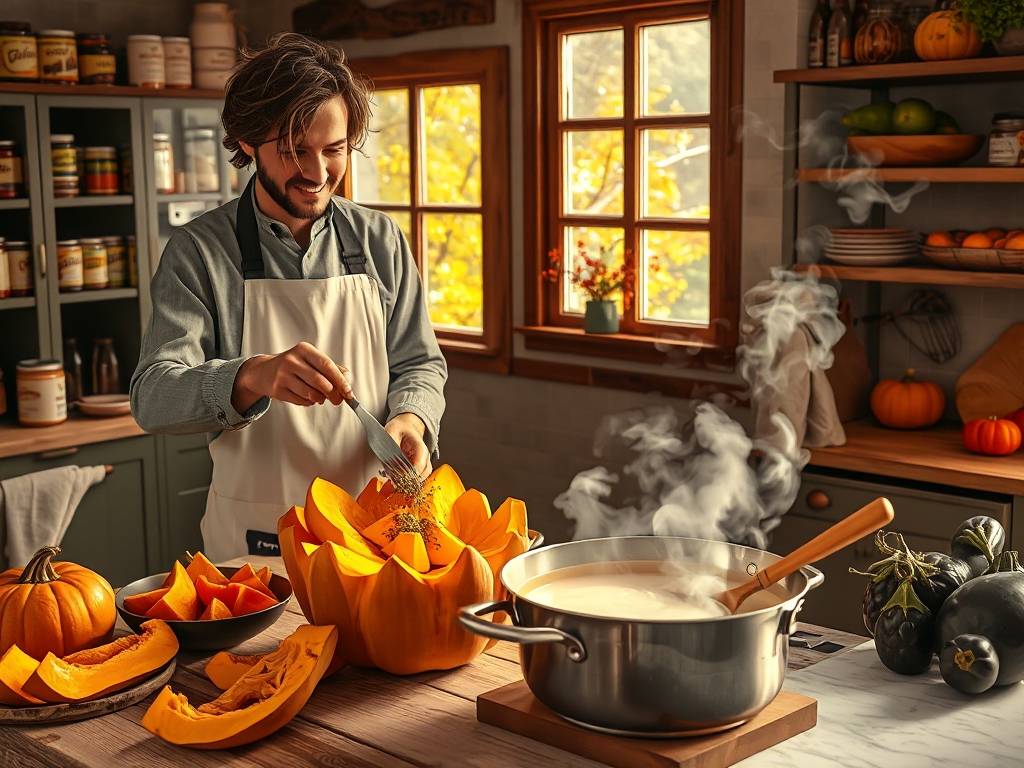How to Make Pumpkin Soup: Roast Pumpkin, Blend with Coconut Milk
There is something deeply comforting about a bowl of warm, creamy pumpkin soup. It’s a dish that evokes the crisp air of autumn, the warmth of the kitchen, and the joy of sharing a meal with loved ones. While there are countless variations of pumpkin soup, one method stands out for its rich, caramelized flavor and luxurious texture: roasting the pumpkin and blending it with creamy coconut milk. This technique transforms humble ingredients into a velvety, aromatic soup that is both nourishing and indulgent.
In this guide, we’ll walk through the process step by step, from selecting the right pumpkin to achieving the perfect consistency and flavor balance. Whether you’re a seasoned cook or a beginner, this recipe is approachable and rewarding. Let’s dive in.
Why Roast the Pumpkin?
Roasting might seem like an extra step compared to simply boiling or steaming the pumpkin, but it’s a game-changer. When pumpkin is roasted, its natural sugars caramelize, deepening the flavor and adding a subtle sweetness and complexity that boiling simply cannot achieve. The edges of the pumpkin pieces become slightly crisp and golden, infusing the soup with a toasted, nutty undertone. Additionally, roasting concentrates the pumpkin’s flavor, making it more robust and satisfying.

Another benefit of roasting is that it enhances the pumpkin’s texture. When blended, roasted pumpkin yields an incredibly smooth and thick puree, which serves as the perfect base for a creamy soup. This method also allows you to season the pumpkin before it even hits the soup pot, ensuring every bite is packed with flavor.
Choosing the Right Pumpkin
Not all pumpkins are created equal when it comes to soup. While the large carving pumpkins might be tempting for their size, they tend to be watery and less flavorful. For the best results, opt for sugar pumpkins, also known as pie pumpkins. These are smaller, sweeter, and have a denser flesh, which makes them ideal for roasting and pureeing.
If sugar pumpkins are unavailable, other winter squash like butternut or kabocha can be excellent substitutes. Butternut squash, in particular, has a similar sweetness and texture and works beautifully in this recipe.
Ingredients You’ll Need
For this recipe, we’re keeping things simple yet flavorful. Here’s what you’ll need:
- 1 medium sugar pumpkin (about 3-4 pounds)
- 2 tablespoons olive oil
- 1 large onion, diced
- 3 cloves garlic, minced
- 4 cups vegetable broth
- 1 can (13.5 oz) coconut milk
- 1 teaspoon ground cumin
- 1/2 teaspoon ground ginger
- 1/4 teaspoon nutmeg (freshly grated if possible)
- Salt and pepper to taste
- Optional toppings: toasted pumpkin seeds, a drizzle of coconut milk, fresh herbs like cilantro or thyme
Step-by-Step Instructions
Step 1: Prepare and Roast the Pumpkin
Start by preheating your oven to 400°F (200°C). While the oven is heating, carefully cut the pumpkin in half and scoop out the seeds and stringy pulp. Don’t throw away the seeds! You can rinse them, toss them with a bit of oil and salt, and roast them separately for a crunchy garnish.
Cut the pumpkin into wedges or large chunks. There’s no need to peel it at this stage—the skin will become soft during roasting and will be easy to remove later. Place the pumpkin pieces on a baking sheet lined with parchment paper. Drizzle with one tablespoon of olive oil and sprinkle with salt and pepper. Use your hands to toss the pumpkin, ensuring each piece is lightly coated with oil.
Roast the pumpkin for 30-40 minutes, or until the flesh is tender and easily pierced with a fork. The edges should be golden brown. Let it cool for a few minutes until it’s safe to handle.
Step 2: Sauté the Aromatics
While the pumpkin is roasting, heat the remaining tablespoon of olive oil in a large pot over medium heat. Add the diced onion and sauté until it becomes soft and translucent, about 5-7 minutes. Add the minced garlic and cook for another minute until fragrant. Be careful not to burn the garlic, as it can turn bitter.
Step 3: Combine and Simmer
Once the pumpkin is cool enough to handle, use a spoon to scoop the flesh away from the skin. Add the roasted pumpkin to the pot with the onions and garlic. Pour in the vegetable broth, and add the cumin, ginger, and nutmeg. Bring the mixture to a gentle boil, then reduce the heat and let it simmer for about 10-15 minutes. This allows the flavors to meld together.
Step 4: Blend Until Smooth
Now comes the fun part: blending the soup. For the creamiest results, use an immersion blender directly in the pot. If you don’t have one, a regular blender will work—just blend the soup in batches to avoid spills. Blend until the soup is completely smooth and velvety.
Step 5: Add Coconut Milk and Adjust Seasoning
Return the soup to the pot if you used a standalone blender. Stir in the coconut milk, reserving a few tablespoons for garnish if desired. Heat the soup gently over low heat—avoid boiling it after adding the coconut milk to prevent curdling. Taste and adjust the seasoning with more salt, pepper, or spices as needed.
Step 6: Serve and Garnish
Ladle the soup into bowls and drizzle with a little extra coconut milk. Sprinkle with toasted pumpkin seeds and fresh herbs for added texture and flavor. This soup pairs wonderfully with crusty bread or a simple green salad.
Tips for Success
- Spice Variations: Feel free to experiment with spices. A pinch of cinnamon or a dash of curry powder can add exciting new dimensions to the soup.
- Creaminess: For an even richer soup, use full-fat coconut milk. Light coconut milk will work but will yield a thinner consistency.
- Storage: This soup stores beautifully in the refrigerator for up to 4 days. It also freezes well—just omit the coconut milk until reheating to maintain the best texture.
- Texture Adjustments: If the soup is too thick, add a bit more vegetable broth or water until it reaches your desired consistency.
The Magic of Coconut Milk
Coconut milk is more than just a dairy-free alternative here—it’s a flavor powerhouse. Its natural creaminess and subtle sweetness complement the roasted pumpkin perfectly, adding a tropical nuance that elevates the soup from ordinary to extraordinary. Coconut milk also brings a richness that feels indulgent without being heavy, making this soup suitable for a wide range of dietary preferences.
Moreover, coconut milk is packed with healthy fats and nutrients, adding an extra layer of nourishment to the dish. It balances the earthiness of the pumpkin and the warmth of the spices, creating a harmonious blend that is both satisfying and wholesome.
Conclusion
Making pumpkin soup by roasting the pumpkin and blending it with coconut milk is a simple yet transformative process. It highlights the natural sweetness and depth of the pumpkin while incorporating the luxurious creaminess of coconut milk. This method results in a soup that is not only delicious but also visually appealing and nutritionally balanced.

Whether you’re preparing a cozy weeknight dinner or hosting a festive gathering, this pumpkin soup is sure to impress. So, the next time you see a sugar pumpkin at the market, bring it home and give this recipe a try. Your taste buds—and your loved ones—will thank you.






发表评论